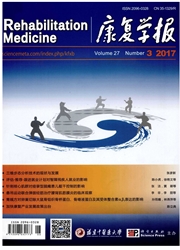

 中文摘要:
中文摘要:
目的:探讨太极拳标准动作的运动模式。方法:受试者按照杨式太极拳"云手"动作进行演练。实验全程使用美国Motion Analysis三维动作捕捉系统进行数据采集,采集肘部、肩部、头部和躯干部运动数据,并对数据进行主成分分析方法。结果:所入选的各关节运动数据均呈相关性(P〈0.01),头部旋转角度与躯干旋转角度呈明显相关性(相关系数0.993,P〈0.01),头部旋转角度与肩关节屈曲角度呈相关性(P〈0.01),肩关节屈曲角度与肘关节屈曲角度呈相关性(P〈0.01);主成分分析结果显示,以躯干旋转角度为因变量、肘关节屈曲角度、肩关节屈曲角度、头部旋转角度为自变量时,各关节均参与完成了云手动作(P〈0.01)。结论:太极拳云手动作可以划分为2个运动成分,康复训练时采取分解各主要成分进行分步教学,再进行完整动作整合训练,这将加快康复患者学习动作的进程,提高动作协调性,以达到高效快速训练的目的。
 英文摘要:
英文摘要:
Objective:In order to improve the effectiveness of rehabilitation training,using the principal component analysis method to study movement characteristics of TAI CHI action. Methods:The subjects played Taijiquan "YUNSHOU" action of YANG style,meanwhile,the three dimensional motion capture system(Motion Analysis) were used for data acquisition,collected motion data of elbow,shoulder,head and body cadres,and then analyzed the data by principal component analysis method. Results:The obtained data were statistically analyzed,which showed that the selected joints motion data were correlated(P〈0.01),head rotation angle and torso rotation angle existed significant correlation(correlation coefficient is 0.993,P〈0.01),head rotation angle and shoulder flexion angle were correlated(P〈0.01),shoulder flexion angle and elbow flexion angle were correlated(P〈0.01);principal component analysis results showed that when the trunk rotation angle was taken as variables,elbow flexion angle,shoulder flexion angle,head rotation angle were considered as independent variables,all the joints were involved in completing the hand movements(P〈0.01). Conclusion:Taijiquan "YUNSHOU" movements can be divided into two main components,the main motion components can be decomposed in the rehabilitation training were conducted,and then whole motion integration training were conducted,it will speed up motor learning process during rehabilitation period,improve coordination of action,thus achieving the purpose of fast and efficient recovery.
 同期刊论文项目
同期刊论文项目
 同项目期刊论文
同项目期刊论文
 期刊信息
期刊信息
